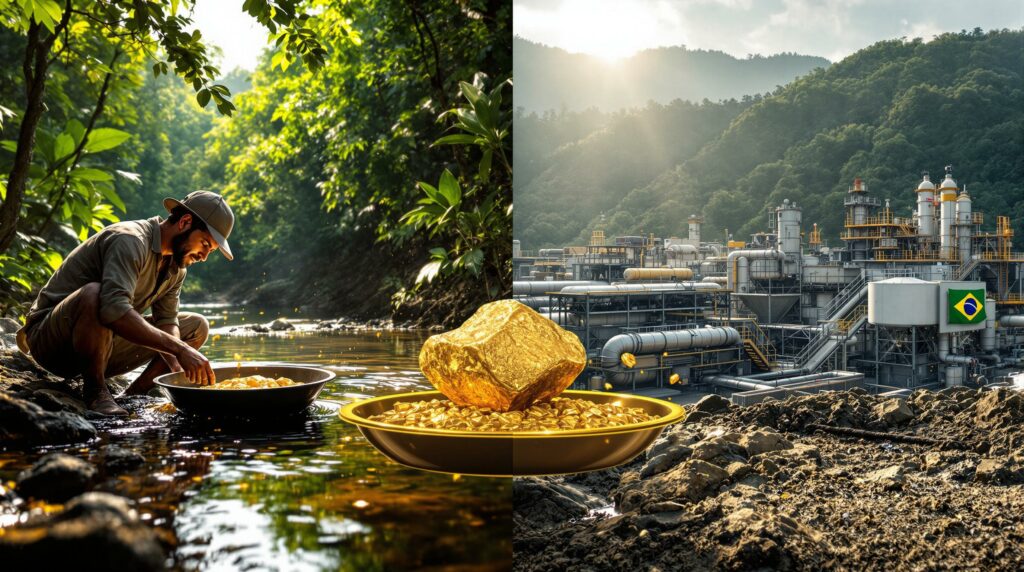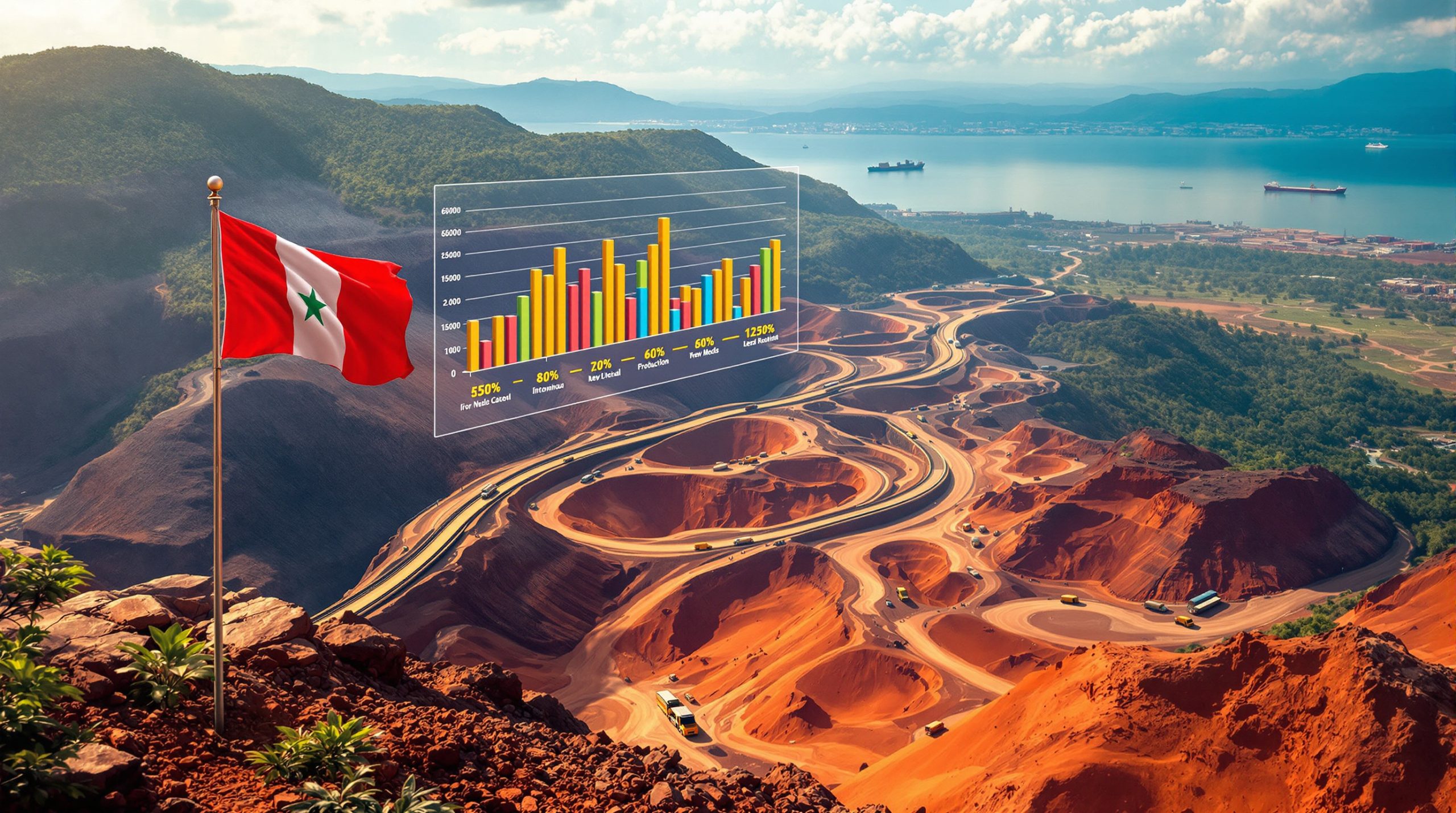The Environmental and Human Cost of Small-Scale Gold Mining
Small-scale gold mining represents a significant portion of the global mining industry, employing over 15 million people worldwide and generating approximately 20% of global gold supplies. Despite providing livelihoods for millions, this sector faces substantial challenges related to environmental degradation, public health concerns, and criminal activity.
The environmental footprint of artisanal and small-scale gold mining (ASGM) is extensive and multifaceted. Mercury contamination spreads through waterways and soil, creating lasting ecological damage. Deforestation destroys critical forest ecosystems, particularly in biodiversity-rich tropical regions. River sedimentation affects aquatic habitats, while soil erosion leads to landscape degradation and contamination of drinking water sources.
These environmental impacts extend beyond local ecosystems, affecting communities and biodiversity across vast regions. The sector supports approximately 100 million people indirectly, making it the largest extractive industry by employment worldwide.
Mercury Pollution: A Global Health Crisis
Health and Environmental Consequences
Mercury use in small-scale gold mining represents the largest source of mercury pollution globally. Miners favor mercury because it's relatively cheap, highly effective at capturing gold particles, and unfortunately, extremely toxic to human health and ecosystems.
When miners use mercury to amalgamate gold, this toxic substance:
- Enters local waterways, contaminating fish populations
- Bioaccumulates in the food chain, affecting wildlife and humans
- Causes neurological damage, particularly in developing children
- Persists in the environment for decades
- Travels through atmospheric circulation, creating pollution far from mining sites
Studies across Amazon mining sites have documented catastrophic health consequences, including neurological disorders, kidney damage, and developmental issues in children. Once released into the environment, mercury can remain active for decades, creating intergenerational health problems.
Mercury Reduction Potential
Centralized gold processing facilities have demonstrated remarkable potential for environmental improvement:
- Reducing mercury use by up to 95%
- Increasing gold recovery rates by approximately 40%
- Significantly lowering toxic exposure for workers and communities
These facilities provide miners with alternatives to mercury amalgamation while simultaneously improving gold yields and working conditions.
The Criminal Network Connection
Criminal Infiltration of Mining Operations
The informal nature of small-scale gold mining has made it increasingly attractive to organized crime groups. Without proper regulation and oversight, criminal organizations are:
- Diversifying from drug trafficking into gold mining
- Extorting workers in remote mining regions
- Using gold to launder illicit profits
- Leveraging mining profits to expand other criminal enterprises
- Controlling remote mining territories through intimidation
In Brazil alone, around half of all gold production is associated with illegal activities. Criminal networks leverage profits from illegal mining to expand their operations in drug trafficking and environmental crimes linked to land grabbing and deforestation.
Environmental Crime Connection
The criminalization of gold supply chains directly impacts conservation efforts:
- Mining operations controlled by criminal groups destroy forests with impunity
- Criminal networks obstruct environmental reforms through violence and corruption
- Intimidation tactics prevent community-based conservation initiatives
- Pollution from criminal mining operations affects protected areas
- Illegal mining frequently encroaches on Indigenous territories
"Drug trafficking cartels, criminal gangs and militia are diversifying into a range of commodities, including gold. Several organized criminal networks are infiltrating gold fields in the Amazon, extorting workers in West Africa, laundering profits across Asia." — Robert Muggah, Igarapé Institute
Transformative Solutions for Small-Scale Mining
Centralized Processing Plants
One promising solution involves investment in centralized gold processing facilities. These plants offer multiple benefits for miners, communities, and the environment:
| Benefit | Impact |
|---|---|
| Mercury reduction | Up to 95% less mercury released into the environment |
| Gold recovery | 40% increase in recovery rates for miners |
| Formalization | Transition of workers from informal to formal employment |
| Traceability | Enhanced ability to track gold from mine to market |
| Tax collection | Improved revenue generation for local governments |
| Job creation | New employment opportunities beyond extraction |
These facilities vary in sophistication and cost. Gravimetric plants separate gold through density differences rather than chemical processing, requiring capital investments starting at approximately $200,000. More advanced cyanidation facilities can cost several million dollars but offer higher recovery rates.
Implementation Challenges
Despite their potential, establishing processing plants faces several obstacles:
- High capital requirements ranging from $200,000 to several million dollars
- Regulatory complexity in many mining regions
- Technical expertise shortages in remote areas
- Risk of capture by criminal networks if not carefully designed
- Cultural resistance to changing traditional mining practices
Overcoming these challenges requires coordinated efforts between governments, international organizations, financial institutions, and mining communities.
Technology as a Catalyst for Formalization
Digital Innovations
Technology plays an increasingly important role in transforming artisanal mining:
- Blockchain systems for traceability and certification
- Mobile platforms for transaction recording and verification
- Satellite monitoring to track mining activity and environmental impacts
- Online permitting systems to simplify regulatory compliance
- Remote sensing to identify illegal operations
These technological solutions help bridge the gap between informal mining practices and formal economic systems, creating pathways for miners to access legal markets and financial services.
Real-World Applications
In Brazil, where approximately 50% of gold production is associated with illegal activities, startups like Certimine are implementing certification platforms to verify operations across more than 120 mining sites. These systems help distinguish legal gold from that produced through illegal operations, creating market incentives for responsible mining.
Other technological innovations include:
- Mobile applications that allow miners to record production and sales
- Digital banking solutions for unbanked mining communities
- Remote monitoring systems to track environmental compliance
- Satellite imagery analysis to detect illegal mining operations
Policy Frameworks for Sustainable Mining
Regulatory Improvements
Effective formalization requires comprehensive policy reforms:
- Simplified licensing procedures for small-scale miners to reduce barriers to entry
- Clear land rights and resource access frameworks to reduce conflicts
- Incentives for legal gold processing and sales through tax benefits and market access
- Protection from criminal extortion and violence through security measures
- Banking access for formalized miners to reduce vulnerability to exploitation
- Tax structures that encourage compliance while supporting local development
These reforms must balance environmental protection with economic opportunity, recognizing the importance of mining livelihoods while addressing their environmental impacts.
Balancing Enforcement and Incentives
While enforcement operations like Brazil's recent cross-border initiative (Operation Green Shield) are necessary, they must be complemented by positive incentives:
- Price premiums for responsibly sourced gold
- Tax benefits for compliant facilities
- Technical assistance programs for miners transitioning to cleaner methods
- Access to formal credit and banking services
- Community ownership models that distribute benefits equitably
Operation Green Shield, carried out by Brazil, Colombia, Ecuador and Peru, resulted in 15 arrests and seizure or destruction of criminal assets worth about $30 million. However, enforcement alone cannot address the root causes of illegal mining.
Economic Drivers of Artisanal Gold Mining
Market Dynamics
The global gold market has seen dramatic price increases, with gold values rising more than 500% since 2008 to over $3,300 per ounce in 2025. This record gold prices analysis is driven by:
- Inflation concerns in major economies
- High interest rates affecting investment patterns
- Geopolitical instability creating market uncertainty
- Investor demand for safe-haven assets
- Supply constraints in formal mining sectors
These market forces create powerful economic incentives for artisanal mining activity, including illegal operations in environmentally sensitive areas. The high value of gold relative to its weight and the ease of transportation make it particularly attractive for both legitimate miners and criminal networks.
Economic Vulnerability
Many small-scale miners operate in a context of economic vulnerability:
- Limited alternative livelihood options
- Lack of access to formal financial services
- High dependence on middlemen who capture much of the value
- Price volatility affecting income stability
- Exposure to exploitative labor practices
Addressing these economic vulnerabilities is essential for successful formalization efforts.
International Cooperation and Global Standards
Global Initiatives
Several international frameworks address aspects of small-scale mining:
- The Minamata Convention on Mercury aims to reduce mercury use globally
- The planetGOLD initiative supports countries in addressing mercury use in ASGM
- World Gold Council sustainability standards promote responsible mining practices
- OECD Due Diligence Guidance provides frameworks for minerals sourcing
- Regional cooperation agreements in the Amazon coordinate cross-border efforts
These international frameworks provide important tools for addressing the complex challenges of small-scale mining, but implementation remains challenging in many regions.
COP30 Opportunity
The upcoming COP30 climate summit in Brazil's Amazon region presents a strategic opportunity to elevate small-scale gold mining issues on the international agenda, particularly regarding:
- Climate impacts of mining-driven deforestation
- Biodiversity conservation in mining regions
- Community development alternatives
- Technology transfer for cleaner mining
- Financing mechanisms for processing infrastructure
This summit could catalyze new commitments and resources for transforming small-scale mining practices, particularly in the Amazon region where mining impacts are significant.
Success Stories in Mining Formalization
Case Studies
Promising experiences in formalizing small-scale gold production include:
-
Peru: Implementation of mercury-free processing plants in mining regions, with five metallurgical facilities operating under improved environmental standards
-
Tanzania: Development of artisanal mining centers with mercury-free gold smelting technologies, supported by environmental authorities
-
Burkina Faso: Scaling of legal trade channels for artisanal gold through partnerships between international organizations and private sector actors
-
Mongolia: Transformation of informal mining through the planetGOLD project, which concluded with significant improvements in environmental practices
These case studies demonstrate that with appropriate support, small-scale mining can transition toward more sustainable and responsible practices.
Community Benefits of Formalization
Social and Economic Advantages
Beyond environmental improvements, formalization of small-scale gold mining and environmental impacts offers significant community benefits:
- Improved worker safety and health conditions through better practices
- More stable and predictable income streams
- Reduced vulnerability to criminal exploitation and violence
- Enhanced community development opportunities through tax revenues
- Greater voice in resource governance and decision-making
- Potential for certification and premium pricing in responsible gold markets
When properly implemented, formalization can transform mining from an environmental liability to a driver of sustainable development.
Alternative Livelihood Development
Successful formalization must include pathways to diversified local economies:
- Value-added processing activities that capture more of the gold value chain
- Service businesses supporting mining operations
- Agricultural enterprises using rehabilitated land
- Ecotourism in restored mining areas
- Craft production using mining byproducts
Diversification reduces communities' vulnerability to gold market surge fluctuations and creates more resilient local economies.
Addressing Common Questions About Small-Scale Gold Mining
What percentage of global gold comes from small-scale mining?
Approximately 20% of global gold supplies are produced through artisanal and small-scale mining operations, making it a significant contributor to global gold markets.
How many people depend on small-scale gold mining for their livelihoods?
More than 15 million people work directly in small-scale gold mining, with an estimated 100 million people indirectly supported by the sector, making it the largest extractive industry by employment.
What makes mercury particularly dangerous in gold mining?
Mercury is a potent neurotoxin that persists in the environment, bioaccumulates in food chains, and causes severe health impacts, particularly in developing children. Its effects can span generations and spread far beyond mining sites.
How does illegal gold mining connect to other criminal activities?
Criminal networks use gold mining to launder money from drug trafficking, expand territorial control, and diversify their illicit revenue streams. Gold's high value, portability, and global demand make it particularly attractive for criminal organizations.
What is the estimated cost of establishing a centralized gold processing facility?
Costs range from approximately $200,000 for basic gravimetric processing plants to several million dollars for full cyanidation facilities, depending on capacity and technology.
The Path Forward
Formalizing small-scale gold mining represents one of the most significant opportunities to reduce environmental damage while simultaneously addressing criminal activity and improving livelihoods. The transformation of this sector requires coordinated action across multiple fronts:
- Technological innovation to provide alternatives to mercury use
- Policy reform to create accessible pathways to formalization
- Financial investment in processing infrastructure
- Market incentives for responsibly produced gold
- Community engagement to ensure equitable benefits
"Gold's glitter will not fade, but if mined without reform, it will continue costing the world its forests, its rivers, and its security." — Robert Muggah, Igarapé Institute
The stakes are high, but so is the potential for positive change. By addressing the challenges of small-scale gold mining, we can protect critical ecosystems, improve human health, reduce criminal activity, and support sustainable livelihoods for millions of people worldwide. The mining industry evolution continues to present opportunities for implementing modern mine planning & ESG practices, alongside advancements in mine reclamation innovation that could provide crucial solutions for the sector's most pressing environmental challenges.
Want to Stay Ahead of Major Gold Discoveries?
Discover potentially transformative ASX gold announcements before the market with Discovery Alert's proprietary Discovery IQ model, delivering real-time alerts on significant mineral finds. Visit the Discovery Alert discoveries page to see how historic gold discoveries have generated substantial returns for early investors.




